04. 字符串和 input
1. 字符串的创建
三种方法:
- 单引号
- 双引号
- 三个单引号(三个双引号)
- 单引号、双引号
string = 'I am born for this.' #英文表达
#string = 'I'm born for this.' # I am 缩写成 I‘m,与表示字符串的引号冲突,错误。
string = "I'm born for this." # 正确表达
print(string)
#-------output-------
I'm born for this.问题:无法直接输出段落。
string = "我们有时候不仅仅要看选择项以内的答案,也要去思考选择项以外的答案。——AI悦创\
\
浅者见浅,深者见深——黄家宝\
\
起的最早的是理想主义者,跑的最快的是骗子,而胆子最大的是那些冒险家,害怕错过一切,疯狂往里冲的是韭菜,而真正的成功者,可能还没有入场。\
\
先实现功能,再去优化,否则一切会很乱。——AI悦创\
\
凡是你不能清晰写下来的东西,都是你还没有真正理解的东西"
print(string)
#-------output------- 在每行末尾增加反斜杠,虽然能解决单/双引号无法输出段落的问题,但输出的内容没有格式。
我们有时候不仅仅要看选择项以内的答案,也要去思考选择项以外的答案。——AI悦创浅者见浅,深者见深——黄家宝起的最早的是理想主义者,跑的最快的是骗子,而胆子最大的是那些冒险家,害怕错过一切,疯狂往里冲的是韭菜,而真正的成功者,可能还没有入场。先实现功能,再去优化,否则一切会很乱。——AI悦创凡是你不能清晰写下来的东西,都是你还没有真正理解的东西三个单引号(三个双引号)
特点:段落原样输出。
string = """我们有时候不仅仅要看选择项以内的答案,也要去思考选择项以外的答案。——AI悦创 浅者见浅,深者见深——黄家宝 起的最早的是理想主义者,跑的最快的是骗子,而胆子最大的是那些冒险家,害怕错过一切,疯狂往里冲的是韭菜,而真正的成功者,可能还没有入场。 先实现功能,再去优化,否则一切会很乱。——AI悦创 凡是你不能清晰写下来的东西,都是你还没有真正理解的东西""" print(string) #-------output------- 我们有时候不仅仅要看选择项以内的答案,也要去思考选择项以外的答案。——AI悦创 浅者见浅,深者见深——黄家宝 起的最早的是理想主义者,跑的最快的是骗子,而胆子最大的是那些冒险家,害怕错过一切,疯狂往里冲的是韭菜,而真正的成功者,可能还没有入场。 先实现功能,再去优化,否则一切会很乱。——AI悦创 凡是你不能清晰写下来的东西,都是你还没有真正理解的东西
2. 字符串的长度 len()
paragraph = "Hello, Ran!"
print(len(paragraph))
#-------output-------
11字符串是从1开始数,下标从左到右是从0开始,注意区分。因此,字符串长度 - 1 = 下标最大值。
3. 字符串的获取
获取单个字符
string = "bornforthis" select = string[10] # 方法一: 1. 注意是方括号;2. 方括号内为字符串下标;3. 从左向右的下标 select = string[-1] # 方法二: 从右向左的下标 select = string[len(string)-1] # 方法三: 取最后一位,可以参考长度和下标的转换 print(select) #-------output------- s获取一串连续字符
方法一:从左向右取下标
string = "bornforthis" select = string[0: 4] #中括号内第一位数字表示字符串开始位置的下标,第二位数字表示结束位置的下标+1,用数学解释即 [0, 4) print(select) #-------output------- born方法二:从右向左取下标(右数第一位下标是 ``-1
如何实现end + 1`?)错误取负数下标string2 = "bornforthis" select2 = string2[-4:-1] print(select2) #-------output------- thi正确取负数下标string2 = "bornforthis" select2 = string2[-4:] #-4 是负数下标,end 处空白默认从左向右取到字符串的最后,就不需要考虑 end + 1 没有对应下标的问题,end 部分未指定,则默认从左向右取 print(select2) #-------output------- this
获取等间隔的字符
string = "0123456789" select = string[1: len(string): 2] #语法:select = string[start: end: step] step指步长,即走几步 or 两相邻字符下标相减 print(select) string2 = "bornforthis" select2 = string2[0: len(string2): 3] print(select2) select3 = string2[1: len(string2): 3] print(select3) #-------output------- 13579 bnri ofts若要取的字符串开头/结尾是整段的字符串的开头/结尾,则可以省略 start 和 end,不是整段字符串开头/结尾则不能省略下标。
string = "0123456789" select = string[1:: 2] print(select) string2 = "bornforthis" select2 = string2[:: 3] print(select2) select3 = string2[1:: 3] print(select3) #-------output------- 13579 bnri ofts负数下标的提取(下标从右向左)
string = "0123456789" select = string[-1: -11: -1] #可简写成 select = string[:: -1] 步长 -1 表示从右向左取(-),每次走1步,只有步长方向和start-end方向一致时才能输出结果 print(select) #-------output------- 9876543210思考流程:
4. 字符串的内置方法
4.1 .upper()
将字符串内容全部变为大写。
string = "bornforthis"
upper_string = string.upper()
print(upper_string)
#-------output-------
BORNFORTHIS4.2 .lower()
将字符串内容全部变为小写。
string = "BORNFORTHIS"
lower_string = string.lower()
print(lower_string)
#-------output-------
bornforthis4.3 .capitalize()
将字符串首字母大写。(只对第一个字母大写,其他后面的字母变为小写)
string = "bornForthis to Aivc"
capitalize_string = string.capitalize()
print(capitalize_string)
#-------output-------
Bornforthis to aivc4.4 .title()
将字符串中每个单词的首字母大写,其余字符都转换成小写。
string = "bornforthis to aivc"
title_string = string.title()
print(title_string)
#-------output-------
Bornforthis To Aivcstring = "bornforthis-to-aivc"
title_string = string.title()
print(title_string)
#-------output-------
Bornforthis-To-Aivcstring = "boRnforThis to aIvc"
title_string = string.title()
print(title_string)
#-------output-------
Bornforthis To Aivc4.5 .startswith()
检测字符串是否以特定字符或单词开头,返回布尔值(若是该字符开头,则返回 True ,若不是则返回 False 。
string = "bornforthis"
startswith_string= string.startswith("b")
print(startswith_string)
#-------output-------
Truestring = "bornforthis"
startswith_string= string.startswith("bo")
print(startswith_string)
#-------output-------
Truestring = "bornforthis"
startswith_string= string.startswith("p")
print(startswith_string)
#-------output-------
Falsestring = "bornforthis"
startswith_string= string.startswith("b1")
print(startswith_string)
#-------output-------
False4.6 .endswith()
检测字符串是否以特定的字符或单词结尾,返回布尔值。
string = "bornforthis"
endswith_string= string.endswith("s")
print(endswith_string)
#-------output-------
Truestring = "bornforthis"
endswith_string= string.endswith("is")
print(endswith_string)
#-------output-------
Truestring = "bornforthis"
endswith_string= string.endswith("i")
print(endswith_string)
#-------output-------
Falsestring = "bornforthis"
endswith_string= string.endswith("s6")
print(endswith_string)
#-------output-------
False4.7 .count()
统计特定字符或单词在目标字符串中存在的次数,若在目标字符串中不存在,则输出 0。
string = "bornforthis"
count_string= string.count("r")
print(count_string)
#-------output-------
2string = "bornforthis"
count_string= string.count("or")
print(count_string)
#-------output-------
2string = "bornforthis"
count_string= string.count("a")
print(count_string)
#-------output-------
0string = "bornforthis"
count_string= string.count("ap")
print(count_string)
#-------output-------
04.8 .find()
寻找目标字符或单词在特定字符串中,第一次出现的下标。也就是说,有重复,也之返回第一次出现的下标;
若查找单词,则返回目标单词第一个字符的下标;
若查询的内容不存在,则返回 -1 。
string = "bornforthis"
find_string= string.find("o")
print(find_string)
#-------output-------
1string = "bornforthis"
find_string= string.find("a")
print(find_string)
#-------output-------
-1string = "bornforthis"
find_string= string.find("for")
print(find_string)
#-------output-------
4string = "bornforthis"
find_string= string.find("aivc")
print(find_string)
#-------output-------
-14.9 .index()
寻找目标字符或单词在特定字符串中,第一次出现的下标。如果是查找单词,那么 index() 返回目标单词的第一个字符下标。
如果查询的字符或单词不存在,则报错。
index() vs. find()
index() 在找不到指定字符/字符串时会报错,提供文件信息和位置,便于定位被搜索的字符串的位置,那么在文件或代码较多的情况下,使用 index() 可以帮助精准定位。但报错会引发程序运行停止,若不希望程序中止,则需要确保检索的字符/字符串一定存在于被检索的字符串中。
find() 的可控性更强,搜索不到时,会返回值 -1 ,但是程序不会停止,在发布或面向用户场景下更为合适。
string = "bornforthis"
index_result = string.index("o")
print(index_result)
#-------output-------
1string = "bornforthis"
index_result = string.index("a")
print(index_result)
#-------output-------
Traceback (most recent call last):
File "D:\Coder\test 1\test 1.1.py", line 2, in <module>
index_result = string.index("a")
ValueError: substring not foundstring = "bornforthis"
index_result = string.index("for")
print(index_result)
#-------output-------
4string = "bornforthis"
index_result = string.index("aivc")
print(index_result)
#-------output-------
Traceback (most recent call last):
File "D:\Coder\test 1\test 1.1.py", line 2, in <module>
index_result = string.index("aivc")
ValueError: substring not found使用场景
# 通过符号 . 的下标提取文件名和后缀
string = "Experiment-record.xlsx"
index_result = string.index('.')
filename = string[:index_result]
suffix = string[index_result+1:]
print(filename)
print(suffix)
#-------output-------
Experiment-record
xlsx使用场景练习
# 根据要提取的内容,检索左侧和右侧内容下标,确定提取的 start 和 end
line = "ID=1234;NAME=Tom;AGE=25"
name_start = line.index('NAME=')
name_end = line.index(';AGE')
name = line[name_start+5:name_end]
print(name_start)
print(name_end)
print(name)
#-------output-------
8
16
Tom4.10 .isdigit()
判断字符串是不是纯数字字符串,字符串中但凡有个字符是非数字,则返回 False (若输入的是负数,依旧带负号 - ,因此会判断为 False )。
string = "12345678"
isdigit_result = string.isdigit()
print(isdigit_result)
#-------output-------
Truestring = "1234 5678"
isdigit_result = string.isdigit()
print(isdigit_result)
#-------output-------
False4.11 .isalpha()
判断字符串是不是纯字母字符串,字符串中但凡有一个非字母的,则返回 False 。
string = "Impeppapig"
isalpha_result = string.isalpha()
print(isalpha_result)
#-------output-------
Truestring = "Im peppa pig"
isalpha_result = string.isalpha()
print(isalpha_result)
#-------output-------
False4.12 .isalnum()
判断字符串是否纯数字、纯字母、纯数字字母字符串,字符串中如果包含任何非数字或字母字符,则返回 False 。
code = "peppapig1"
valid_code = code.isalnum()
print(valid_code)
#-------output-------
Truecode = "peppa pig1"
valid_code = code.isalnum()
print(valid_code)
#-------output-------
False4.13 .isupper()
判断字符串是否全大写字母组成。
name = "PEPPERPIG"
isupper_name = name.isupper()
print(isupper_name)
#-------output-------
Truename = "PEPPER PIG1-"
isupper_name = name.isupper()
print(isupper_name)
#-------output-------
Truename = "PEPPERpig"
isupper_name = name.isupper()
print(isupper_name)
#-------output-------
Falsename = "pepperpig"
isupper_name = name.isupper()
print(isupper_name)
#-------output-------
False4.14 .islower()
判断字符串是否全小写字母组成。
name = "pepper pig1-=、"
islower_name = name.islower()
print(islower_name)
#-------output-------
Truename = "PEPPERpig"
islower_name = name.islower()
print(islower_name)
#-------output-------
Falsename = "PEPPERPIG"
islower_name = name.islower()
print(islower_name)
#-------output-------
False4.15 .isspace()
判断字符串是否全部由空格组成,注意区分空格字符串和空字符串。
input1 = " "
isspace_input1 = input1.isspace()
print(isspace_input1)
#-------output-------
Trueinput1 = ""
isspace_input1 = input1.isspace()
print(isspace_input1)
#-------output-------
Falseinput1 = "123asd-=["
isspace_input1 = input1.isspace()
print(isspace_input1)
#-------output-------
False4.16 .strip()
- 字符串前后需要清除的内容相同
string = " I'm pepper pig. "
strip_string = string.strip()
print("Original string:", string)
print("String after stripping:", strip_string)
#-------output-------
Original string: I'm pepper pig.
String after stripping: I'm pepper pig.string = "----I'm pepper pig.----"
strip_string = string.strip("-")
print("Original string:", string)
print("String after stripping:", strip_string)
#-------output-------
Original string: ----I'm pepper pig.----
String after stripping: I'm pepper pig.- 需要清除的内容不同
string = "--- -I'm pepper pig.-- ?--"
strip_string = string.strip(" -?") #把要去掉的都扔在里面,不分先后顺序
print("Original string:", string)
print("String after stripping:", strip_string)
#-------output-------
Original string: --- -I'm pepper pig.-- ?--
String after stripping: I'm pepper pig.4.17 .lstrip()
去掉左侧,()内包含的所有字符的连续字符串。
string = " I'm pepper pig. "
lstrip_string = string.lstrip()
print("Original string:", string)
print("String after stripping:", lstrip_string)
#-------output-------
Original string: I'm pepper pig.
String after stripping: I'm pepper pig.string = "-----I'm pepper pig.-----"
lstrip_string = string.lstrip("-")
print("Original string:", string)
print("String after stripping:", lstrip_string)
#-------output-------
Original string: -----I'm pepper pig.-----
String after stripping: I'm pepper pig.-----string = "--!--?-I'm pepper pig.-!---?-"
lstrip_string = string.lstrip("?-!")
print("Original string:", string)
print("String after stripping:", lstrip_string)
#-------output-------
Original string: --!--?-I'm pepper pig.-!---?-
String after stripping: I'm pepper pig.-!---?-4.18 .rstrip()
去掉右侧,()内包含的所有字符的连续字符串。
使用方法同 lstrip()
4.19 .replace()
.replace(old, new count) 括号内第一个位置传入需要替换的 ”旧字符“ ,第二个位置传入要替换的 ”新字符“ ,默认替换全部,count 控制替换次数。
string = "I'm pepper pig."
replace_result = string.replace(" ", "!")
print("原本的字符串:", string)
print("替换后的字符串:", replace_result)
#-------output-------
原本的字符串: I'm pepper pig.
替换后的字符串: I'm!pepper!pig.string ="ai-peppapig-ai"
replace_result = string.replace ("ai", "love", 1)
print("原本的字符串:", string)
print("替换后的字符串:", replace_result)
#-------output-------
原本的字符串: ai-peppapig-ai
替换后的字符串: love-peppapig-ai4.20 .split()
.split(sep, maxsplit) 以特定字符进行分割,默认空格分割。
若传入参数 sep ,则以参数进行分割。
返回的为分割后的列表。
maxsplit 用于控制分割次数。
string ="I'm peppa pig."
split_result = string.split()
print("原本的字符串:", string)
print("替换后的字符串:", split_result)
#-------output-------
原本的字符串: I'm peppa pig.
替换后的字符串: ["I'm", 'peppa', 'pig.']string ="I'm-peppa-pig."
split_result = string.split('-')
print("原本的字符串:", string)
print("替换后的字符串:", split_result)
#-------output-------
原本的字符串: I'm-peppa-pig.
替换后的字符串: ["I'm", 'peppa', 'pig.']string ="I'm-peppa-pig."
split_result = string.split( "-", 1)
print("原本的字符串:", string)
print("替换后的字符串:", split_result)
#-------output-------
原本的字符串: I'm-peppa-pig.
替换后的字符串: ["I'm", 'peppa-pig.']string ="I'm--------peppa--------pig."
split_result = string.split("-")
print("原本的字符串:", string)
print("替换后的字符串:", split_result)
#-------output-------
原本的字符串: I'm--------peppa--------pig.
替换后的字符串: ["I'm", '', '', '', '', '', '', '', 'peppa', '', '', '', '', '', '', '', 'pig.']注意:第4种情况,遇到连续的分割字符时,若指定分割字符,则会返回空字符串,因此需要注意,因为默认是空格分割,因此不需要空字符串时直接默认即可。
具体使用中遇到的情况参见: https://pythiaroot.com/programming/python/08-set.html#_16-小试牛刀
4.21 .rsplit()
.rsplit(sep, maxsplit) 从字符串右边开始分割。
可以传入参数 sep 来指定分隔符。
返回为分割后的列表。
maxsplit 用于控制分割次数,默认值为 -1,表示不限制分割次数。
string ="I'm-peppa-pig."
rsplit_result = string.rsplit("-",1)
print("原本的字符串:", string)
print("替换后的字符串:", rsplit_result)
#-------output-------
原本的字符串: I'm-peppa-pig.
替换后的字符串: ["I'm-peppa", 'pig.']4.22 .join()
.join(iterable) 将可迭代(指可以继续拆分)对象(如列表、元组等)中的字符串元素连接成一个新的字符串,可以指定连接符。
string ="peppapig"
join_result = '-'.join(string) #注意语法与前文不同,join括号里是字符串变量,前面为连接符
print("原本的字符串:", string)
print("替换后的字符串:", join_result)
#-------output-------
原本的字符串: peppapig
拼接后的字符串: p-e-p-p-a-p-i-gstring_list = ["I", "am", "peppa", "pig"]
join_result = "-".join(string_list)
print("原本的列表:", string_list)
print("拼接后的列表:", join_result)
#-------output-------
原本的列表: ['I', 'am', 'peppa', 'pig']
拼接后的列表: I-am-peppa-pig4.23 Quiz
统计下面字符串中的字数,不包含标点符号、空格、换行,字符串内容如下:
亲爱的黄艳医生:
新年好!时光飞逝,婉棠已经满满长大,我们永远感激您在龙年时给予我们的那份守护和祝福。是您的细心和专业,让我们的家庭迎来了最珍贵的礼物。
蛇年的钟声已敲响,愿新年的每一天都像您的微笑一样温暖,每个夜晚都如您的双手一样安心。感谢您让我们的家充满了欢笑与爱。祝您和家人龙腾虎跃、岁岁平安、幸福安康!
此致
敬祝新春快乐
婉棠一家敬上
答案:
para = """
亲爱的黄艳医生:
4.24 字符串格式化(按照一定的格式输出)
格式化:按照一定的格式输出。
- 解决重复创建问题
string = "Hello, peppa pig, I come from China."
print(string)
string1 = "Hello, "
name = "peppa pig"
string2 = ", I come from "
region = "China"
string3 = "."
welcome_sentence = string1 + name + string2 + region + string3
print(welcome_sentence)
#-------output-------
Hello, peppa pig, I come from China.
Hello, peppa pig, I come from China.但采用上述方法存在**”不同数据类型无法相加“**的问题,会报错。
string1 = "Hello, "
name = "peppa pig"
string2 = ", I come from "
region = "China"
string3 = "."
age = 18
welcome_sentence = string1 + name + string2 + region + string3 + age
print(welcome_sentence)string1 = "Hello, "
name = "peppa pig"
string2 = ", I come from "
region = "China"
string3 = "."
age = 18
welcome_sentence = string1 + name + string2 + region + string3 + str(age)
print(welcome_sentence)
#-------output-------
Hello, peppa pig, I come from China.18- 更好的解决办法:字符串格式化,有三种方法,如下。
4.24.1 .format()
方法一: 语法:string = "Hi {}, Welcome to China.".format("peppa pig")
#直接使用
string = "Hi {}, Welcome to China.".format("peppa pig")
print(string)
#借助变量,定好模板
template_string = "Hi {}, Welcome to China."
formatted_string = template_string.format("peppa pig")
print(formatted_string)
#-------output-------
Hi peppa pig, Welcome to China.
Hi peppa pig, Welcome to China.string = "Hi {}, Welcome to {}.".format("peppa pig", "China")
print(string)
template_string = "Hi {}, Welcome to {}."
formatted_string = template_string.format("peppa pig", "China")
print(formatted_string)string = "Hi {1}, Welcome to {0}.".format("China", "peppa pig") # 花括号里为输入的下标
print(string)
template_string = "Hi {1}, Welcome to {0}."
formatted_string = template_string.format("China", "peppa pig")
print(formatted_string)
#-------output-------
Hi peppa pig, Welcome to China.
Hi peppa pig, Welcome to China.string = "Hi {name}, Welcome to {region}.".format(region = "China", name = "peppa pig") # 花括号里为输入的下标
print(string)
template_string = "Hi {name}, Welcome to {region}."
formatted_string = template_string.format(region = "China", name = "peppa pig")
print(formatted_string)
#-------output-------
Hi peppa pig, Welcome to China.
Hi peppa pig, Welcome to China.string = "Money is {}.".format(300) #可以输入多种数据类型,如列表、元组、字典等。
# string = "This is {}. Money is {}.".format("apple", 300)
# string = "This is {}. Money is {}.".format("apple", [1, 2, 3])
# string = "This is {}. Money is {}.".format("apple", (1, 2, 3))
# string = "This is {}. Money is {}.".format("apple", {"name": "ran", "age": 29, 1: "int"})
# string = "This is {}. Money is {}.".format("apple", True)
print(string)
#-------output-------
Money is 300.
# This is apple. Money is 300.
# This is apple. Money is [1, 2, 3].
# This is apple. Money is (1, 2, 3).
# This is apple. Money is {"name": "ran", "age": 29, 1: "int"}.
# This is apple. Money is True.string = "This is {}. Money is {number:.3f}.".format("apple", number = 300) # :.3f 表示保留3位小数
print(string)
#-------output-------
This is apple. Money is 300.000.4.24.2 f-string
Python 3.6+ 及以上版本引入了 f-string ,可以直接将变量嵌入到字符串中,更加简洁。
通过直接在字符串中嵌入变量来生成格式化字符串。
name = "peppapig"
region = "China"
string = f"Hi {name}, welcome to {region}!"
print(string)
#-------output-------
Hi peppapig, welcome to China!4.24.3 % 格式化
方法三:
在 Python 中,% 字符串格式化是一种较老的字符串格式化方式,它虽然已经被更强大和灵活的 .format() 方法和 f-string 所取代,但在某些场景中仍然会被使用。特别是在一些特殊代码指令中使用的较为频繁,并且处理模板语言、日志格式、旧代码时,% 仍然是一个有效选择。
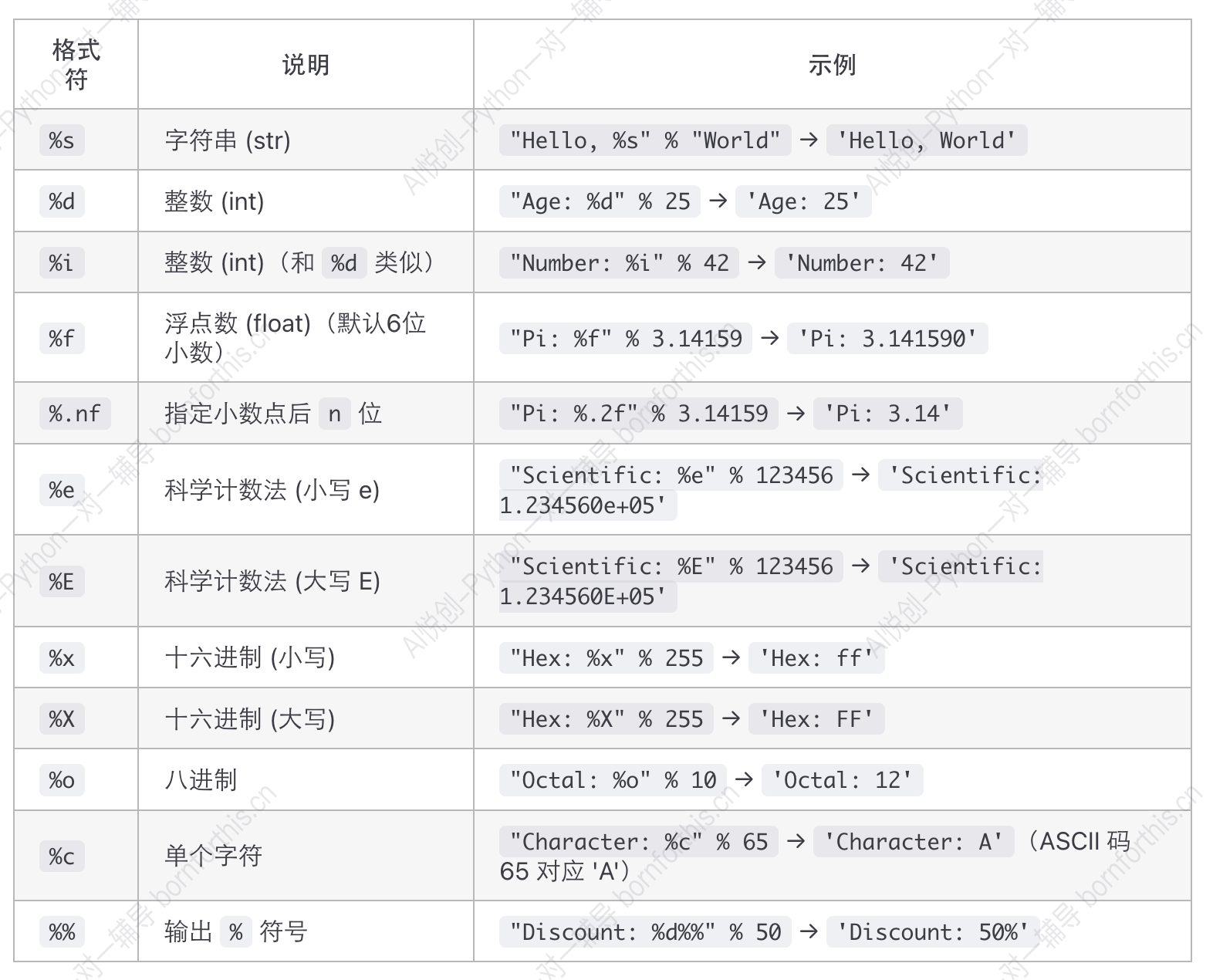
string = "Money is %d."
new_string = string % 13 # 格式化填写后赋值给变量 new_string
print(new_string)
print(string % 19) # 直接格式化后输出
string = "Money is %d." %300
print(string)
#-------output-------
Money is 13.
Money is 19.
Money is 300.string = "Money is %d %s." #两个百分号中间不需要空格也是可以的,如:"Money is %d%s."
new_string = string % (13, "发大财")
print(new_string)
print(string % (168, "一直发"))
string = "Money is %d%s." % (888, "暴富")
print(string)
string = "Money is %d %s." % (888, "暴富")
print(string)
#-------output-------
Money is 13 发大财.
Money is 168 一直发.
Money is 888暴富.
Money is 888 暴富.string = "Money is %.3f." #两个百分号中间不需要空格也是可以的,如:"Money is %d%s."
new_string = string % 168
print(new_string)
print(string % 999)
string = "Money is %.3f." % (888)
print(string)
#-------output-------
Money is 168.000.
Money is 999.000.
Money is 888.000.4.24.4 .format() vs. %格式化
template = "SELECT * FROM table WHERE column = {}"
formatted = template.format("value") # 因为 format 语法中含有{},因此会被解析,结果中不显示{}
print(formatted)
#-------output-------
SELECT * FROM table WHERE column = value #结果 value 没有{}template = "SELECT * FROM table WHERE column = {%s}" % "value"
print(template)
#-------output-------
SELECT * FROM table WHERE column = {value}4.24.5 .format()、%、f-string 优缺点
.format() 需要先建立模板,先写好整个句子,将需要填的内容留空,如:"Hi {}, Welcome to China."
% 与 .format() 类似,也都需要先建立模板。
f-string 则不同,需要先给出内容,如:money = 200, 然后再建立整个句子 string = f"Money is {money:.3f}" 。
4.25 字符串的不可变性
在不用 replace 的情况下,如何修改字符串:
s = "Hello peppa pig!"
s[0] = "a" #由于字符串不可修改,这么写代码会报错
#解决方法:拼接
s = "Hello peppa pig!"
new_s = "a" + s[1:]
print(new_s)
#-------output-------
aello peppa pig!4.26 转义字符
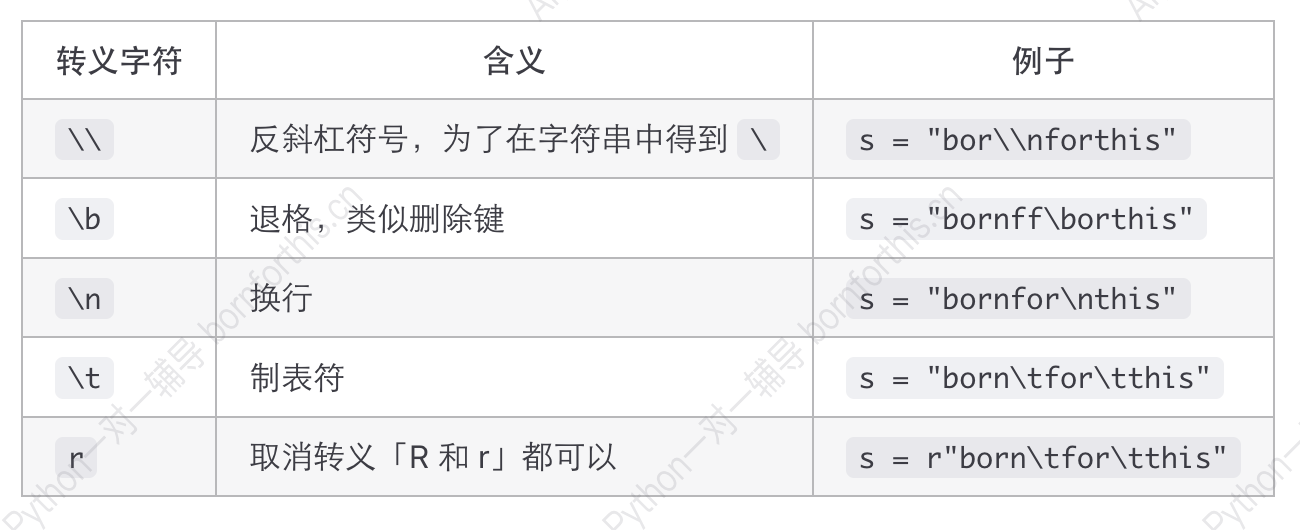
4.27 字符串的拼接
s1 = 'peppa'
s2 = 'pig'
print(s1 + s2)
print(s1, s2)
#-------output-------
peppapig
peppa pig4.28 字符串的乘法
s = '*-love'
print(s * 10)
#-------output-------
*-love*-love*-love*-love*-love*-love*-love*-love*-love*-lovequiz:
# 输出*-love*-love*-love*-love*-love*-love*-love*-love*-love*-love*
#三种方法
s = '*-love'
print(s * 10 + '*')
print(s * 10 + s[0])
print(s * 10, end = "*")4.29 input()
4.29.1 input 的使用
- input 的使用
user_input = input()
print(user_input)
#-------output-------
1234 #此处为输入的内容
1234user_input = input("Enter your name: ")
print(user_input)
#-------output-------
Enter your name: Ran
Ran- input 性质:使用``input()` 得到的返回值的类型始终是字符串,无论输入是什么数据类型,以下用 ipython 展示。
In [1]: type(input(':>>>'))
:>>>1234
Out[1]: str
In [2]: type(input(':>>>')) #使用 type 检测 input 获取用户输入之后的数据类型
:>>>peppapig
Out[2]: str
In [3]: type(input(':>>>'))
:>>>(1, 2, 3, 4)
Out[3]: str
In [4]: type(input(':>>>'))
:>>>[q, w, e, r]
Out[4]: str
In [5]: type(input(':>>>'))
:>>>True
Out[7]: str4.29.2 输入的数据类型转换
解决方法:
- 方法一:强制转换
经过下方测试发现,强制转换时,只会将输入的全部内容按照字符串处理,分解成单独的字符,按照需要转换的格式输出。若输入是带有格式的,如列表、元组、包含符号等,也会全部按照元素输出。因此,能直接转换的只有数字型、布尔型。但是布尔型成功的原因在于:有输入就会输出 True ,没有输入就会显示 False 。
(清空前面的输入:Windows:cls )
In [2]: n = int(input('>>>:'))
>>>:123
In [3]: type(input(':>>>'))
:>>>123
Out[3]: str
In [4]: type(n) #整型
Out[4]: int
In [5]: n = float(input('>>>:'))
>>>:1.2
In [6]: type(n) #浮点型
Out[6]: float
In [7]: n = list(input('>>>:'))
>>>:[1, 2, 'hello world']
In [8]: type(n)
Out[8]: list
In [9]: print(n) #列表
['[', '1', ',', ' ', '2', ',', ' ', "'", 'h', 'e', 'l', 'l', 'o', ' ', 'w', 'o', 'r', 'l', 'd', "'", ']']
In [10]: n = list(input('>>>:'))
>>>:123helloworld
In [11]: print(n)
['1', '2', '3', 'h', 'e', 'l', 'l', 'o', 'w', 'o', 'r', 'l', 'd']
In [12]: n = tuple(input('>>>:'))
>>>:(1, 2, 3, 4, "aivc", 1.1, [1, 2, 3, 4])
In [13]: type(n)
Out[13]: tuple
In [14]: print(n) #元组
('(', '1', ',', ' ', '2', ',', ' ', '3', ',', ' ', '4', ',', ' ', '"', 'a', 'i', 'v', 'c', '"', ',', ' ', '1', '.', '1', ',', ' ', '[', '1', ',', ' ', '2', ',', ' ', '3', ',', ' ', '4', ']', ')')
In [16]: n = bool(input('>>>:'))
>>>:True
In [17]: type(n)
Out[17]: bool
In [18]: print(n) #布尔型
True
In [19]: n = bool(input('>>>:')) #布尔型输入为空,输出为 False
>>>:
In [20]: print(n)
False- 方法二:使用
eval()
eval() 可以判断输入的数据类型,但是需要用户输入时带响应的格式,如字符串需要用引号括起来,列表需要方括号 [] 等,但交互/发布时,若用户不懂编程语言,则无法输入。
In [22]: s = eval(input('>>>:'))
>>>:123
In [23]: type(s), s
Out[23]: (int, 123)
In [24]: s = eval(input('>>>:'))
>>>:[1,2,3,4]
In [25]: type(s), s
Out[25]: (list, [1, 2, 3, 4])
In [26]: s = eval(input('>>>:'))
>>>:(1, 2, 3, 4, "aivc", 1.1, [1, 2, 3, 4])
In [27]: type(s), s
Out[27]: (tuple, (1, 2, 3, 4, 'aivc', 1.1, [1, 2, 3, 4]))
In [28]: s = eval(input('>>>:'))
>>>:{"name": "ran", "age": 29, 1: "int", 1.1: 1, "tup": (1, 2, 3)}
In [29]: type(s), s
Out[29]: (dict, {'name': 'ran', 'age': 29, 1: 'int', 1.1: 1, 'tup': (1, 2, 3)})
In [30]: s = eval(input('>>>:'))
>>>:{1, 2, "ran", 1.1, "book", (1, 2, 3), False}
In [31]: type(s), s
Out[31]: (set, {(1, 2, 3), 1, 1.1, 2, False, 'book', 'ran'})
In [32]: s = eval(input('>>>:'))
>>>:True
In [33]: type(s), s
Out[33]: (bool, True)
In [34]: s = eval(input('>>>:'))
>>>:peppapig
---------------------------------------------------------------------------
NameError Traceback (most recent call last)
Cell In[34], line 1
----> 1 s = eval(input('>>>:'))
File <string>:1
NameError: name 'peppapig' is not defined
In [35]: s = eval(input('>>>:'))
>>>:'peppapig'
In [36]: type(s), s
Out[36]: (str, 'peppapig')探究
为何用 eval() 转换数据类型时,输入字符串时需要加引号?
In [38]: s = input(">>>:")
>>>:peppapig #输入不带引号的字符串,并赋给变量 s
In [39]: s
Out[39]: 'peppapig' # s 输出
In [40]: eval(s) #假设 eval 能转换的原因在于去掉 'peppapig' 的引号,那么去掉后的 s 是 peppapig
---------------------------------------------------------------------------
NameError Traceback (most recent call last)
Cell In[40], line 1
----> 1 eval(s)
File <string>:1
NameError: name 'peppapig' is not defined # peppapig 是变量,因此用 eval 转换时,此处报错
In [41]: s = input(">>>:") #输入带引号的字符串,并赋给变量 s
>>>:"peppapig"
In [42]: s
Out[42]: '"peppapig"' # s 输出
In [43]: eval(s)
Out[43]: 'peppapig' # 用 eval 转换时去掉了引号
In [44]: type(s), s
Out[44]: (str, '"peppapig"') # 虽然进行了转换,但还未赋值给 s ,因此输出的还是原本的 s
In [45]: type(eval(s)), eval(s)
Out[45]: (str, 'peppapig') #转换后的
In [46]: peppapig = "我是粉色吹风机" # 若不加引号,peppapig 则是一个变量,先给它赋值
In [47]: s = input(">>>:")
>>>:peppapig # 输入变量 peppapig
In [48]: s
Out[48]: 'peppapig' # s 只输出 peppapig,并不会输出变量值"我是粉色吹风机",因为没有转换时
# peppapig 只是个字符串,而不是变量名
In [49]: eval(s)
Out[49]: '我是粉色吹风机' # 用 eval 进行转换后才会输出变量值eval() 小技巧:
获取用户输入,实现两位数加减乘除。
In [65]: eval(input('>>>:'))
>>>:1+1
Out[65]: 2
In [66]: eval(input('>>>:'))
>>>:1*2
Out[66]: 2
In [67]: eval(input('>>>:'))
>>>:3-2
Out[67]: 1
In [68]: eval(input('>>>:'))
>>>:9/3
Out[68]: 3.0为什么不推荐使用 eval ?安全性!
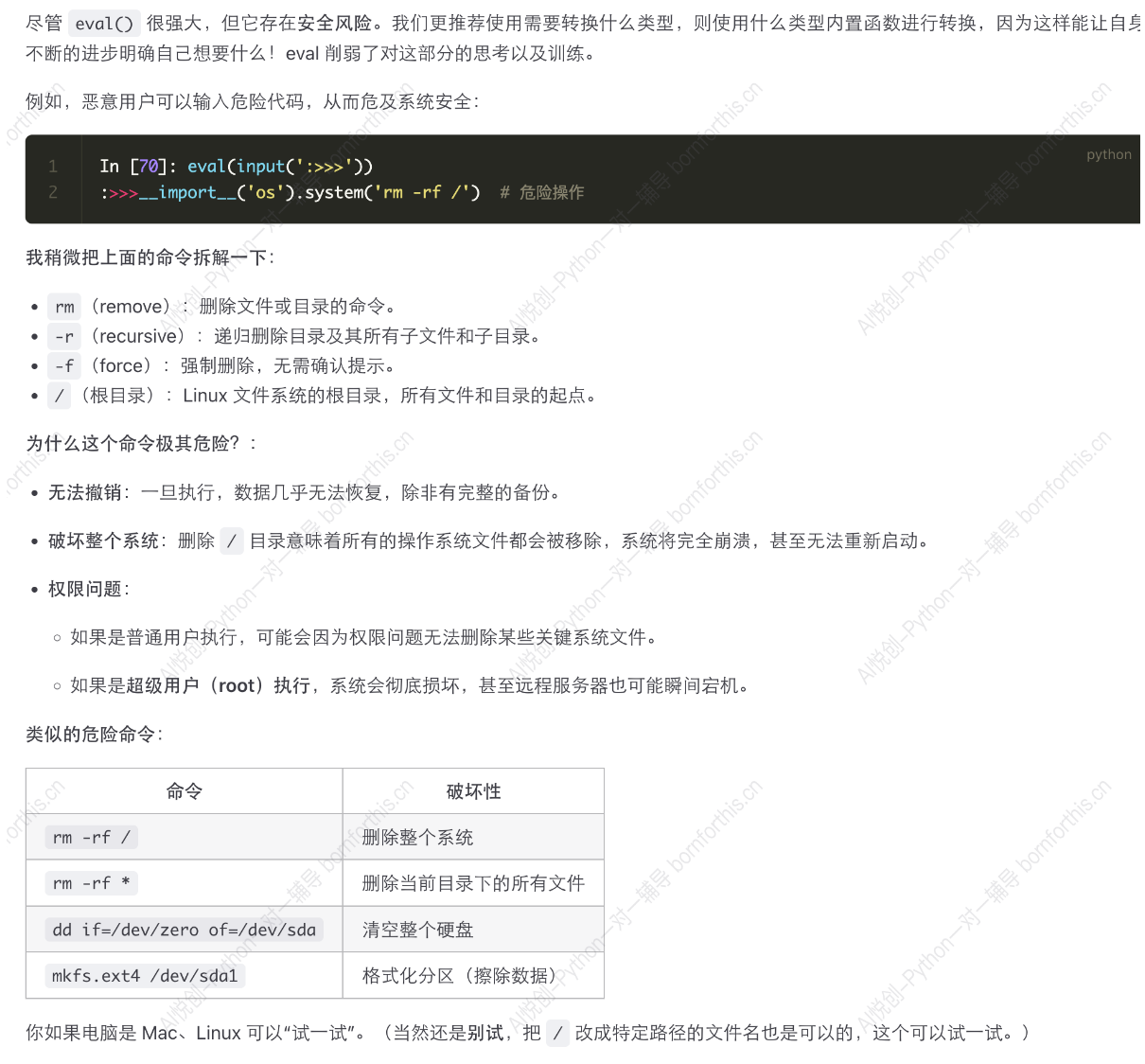
小试牛刀
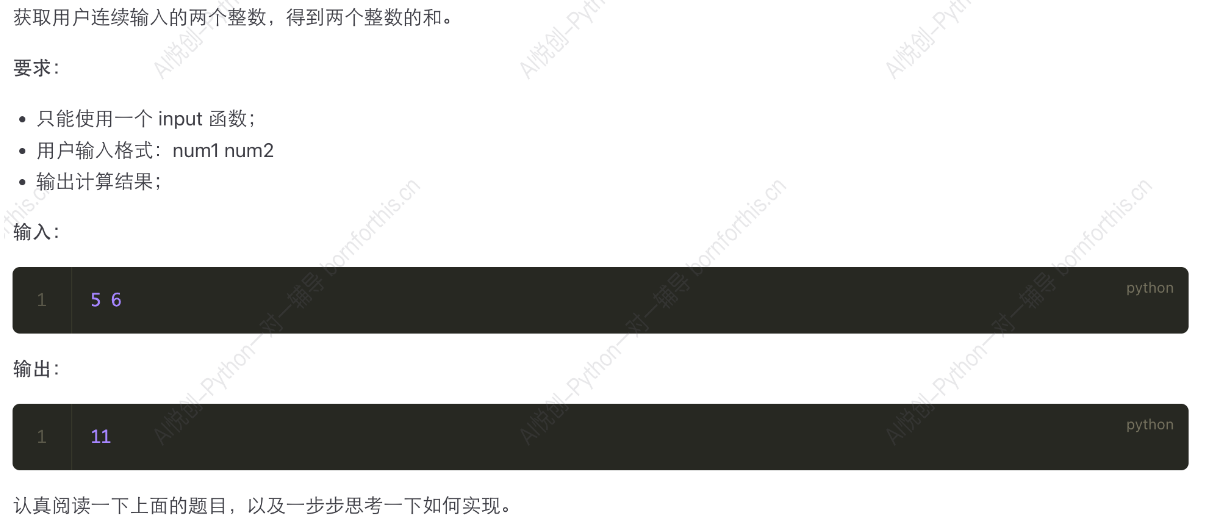
Answer:
num = input()
num_split = num.split() #这一步将操作代码命名为一个变量,方便后续重复调用
num1, num2 = int(num_split[0]), int(num_split[1])
print(num1 + num2)
#-------output-------
7 8
15num = input()
num_replace = num.replace(' ', "+")
print(eval(num_replace))
#-------output-------
7 8
15string = input()
num1, num2 = string.split() # split 的返回值是列表,可以直接赋值多个变量,但注意此时仍是字符串数据
print(eval('int(num1) + int(num2)')) # eval 的特性是去掉引号进行还原,若不强制改变数据类型,则 + 起到的是拼接
# 作用,因此需要先强制转换,但其实eval()此处可以去掉
#-------output-------
7 8
154.30 Assignment

Answer 01:
#拼接方法
name = input('Please enter your name: ')
age = input('Please enter your age: ')
print(name, 'is a', age+'-year-old Siamese cat.')
#-------output-------
Please enter your name: Luna
Please enter your age: 2
Luna is a 2-year-old Siamese cat.# f 方法
name = input('Please enter your name: ')
age = input('Please enter your age: ')
sentence = f'{name} is a {age}-year-old Siamese cat.'
print(sentence)
#-------output-------
Please enter your name: Luna
Please enter your age: 2
Luna is a 2-year-old Siamese cat.# 。format() 方法
template_s = "{name} is a {age}-year-old cat."
formatted_s = template_s.format(name = input('Please enter your name:'), age = input('Please enter your age:'))
print(formatted_s)
#优化
name = input('Please enter your name: ')
age = input('Please enter your age: ')
print("{} is a {}-year-old cat.".format(name, age)) #此处应该填入变量,不能加引号,加引号是字符串,无法引用input的内容
#-------output-------
Please enter your name: Luna
Please enter your age: 2
Luna is a 2-year-old Siamese cat.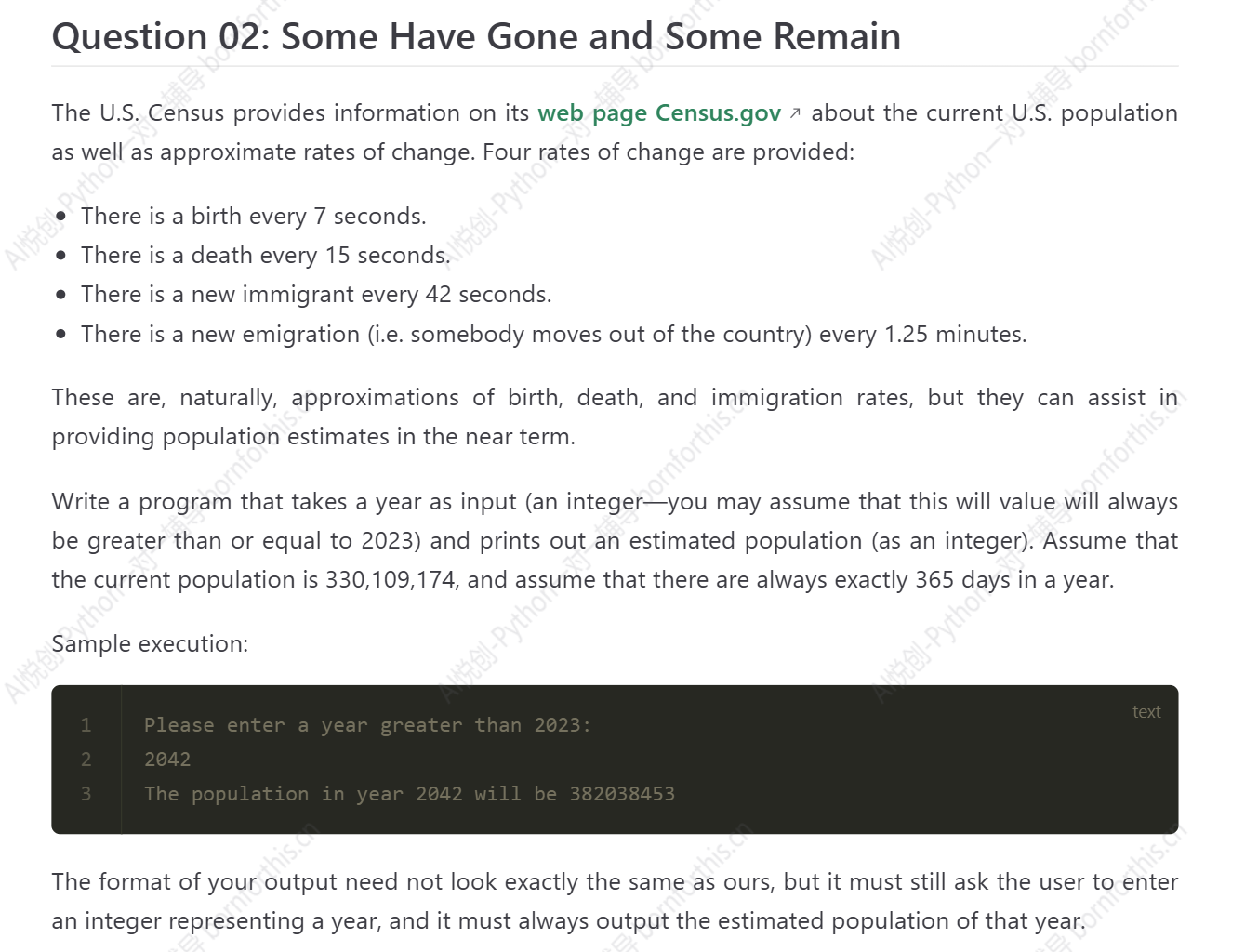
Answer 02:
year = input('Please enter a year you want to estimate (>=2023): ')
secs = (int(year)-2023)*365*24*60*60
birth = secs/7
death = secs/15
immigrant = secs/42
emigrant = secs/(1.25*60)
estimated_population = int(330109174+birth-death+immigrant-emigrant)
print('The population in the year', year, 'will be', estimated_population)
#-------output-------
Please enter a year you want to estimate (>=2023): 2042
The population in the year 2042 will be 382038454 #出现误差纠正优化:
# 获取用户输入的年份
year = int(input('Please enter a year greater than 2023:\n'))
#常量定义,便于之后对当前年份和人口数进行修改
current_year = 2023
current_population = 330109174
seconds_in_year = 365 * 24 * 60 * 60
#变化率
secs = (year-2023)*365*24*60*60
birth = secs//7 #人口是整数,因此此处最好取整
death = -secs//15
immigrant = secs//42
emigrant = -secs//(1.25*60)
estimated_population = int(current_population+birth+death+immigrant+emigrant)
print(f'The population in the year {year} is {estimated_population}.')
#-------output-------
Please enter a year greater than 2023:
2042
The population in the year 2042 is 382038453.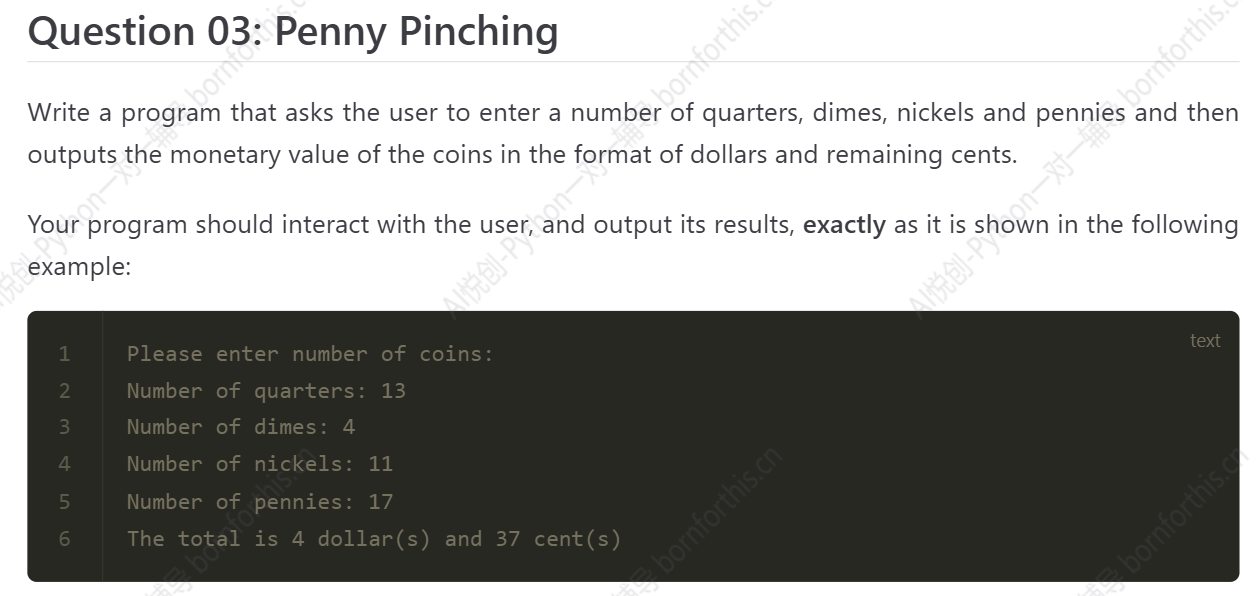
Answer 03:
print('Please enter the number of the coins:')
num_quarters = int(input('quarters:'))
num_dimes = int(input('dimes:'))
num_nickels = int(input('nickels:'))
num_pennies = int(input('pennies:'))
total_c = 25*num_quarters + 10*num_dimes + 5*num_nickels + num_pennies
print('The total is', total_c//100, 'dollar(s)', 'and', total_c%100, 'cent(s).')
#-------output-------
Please enter the number of the coins:
quarters:13
dimes:4
nickels:11
pennies:17
The total is 4 dollar(s) and 37 cent(s).注意:代码逻辑清晰
修改优化:
#用户输入提示语
print('Please enter the number of the coins:')
#获得用户输入,并将其转化为整数
num_quarters = int(input('quarters:'))
num_dimes = int(input('dimes:'))
num_nickels = int(input('nickels:'))
num_pennies = int(input('pennies:'))
#定义每种硬币的价值(单位:美分)
value_quarters = 25 #价值25美分
value_dimes = 10
value_nickels = 5
value_pennies = 1
#根据每种硬币的数量和价值计算总价值(单位:美分)
total_c = value_quarters*num_quarters + value_dimes*num_dimes + \
value_nickels*num_nickels + value_pennies*num_pennies
#计算总美元数和美分数
dollars = total_c//100
cents = total_c%100
#输出总金额
print(f'The total is {dollars} dollar(s) and {cents} cent(s).')
#-------output-------
Please enter the number of the coins:
quarters:13
dimes:4
nickels:11
pennies:17
The total is 4 dollar(s) and 37 cent(s).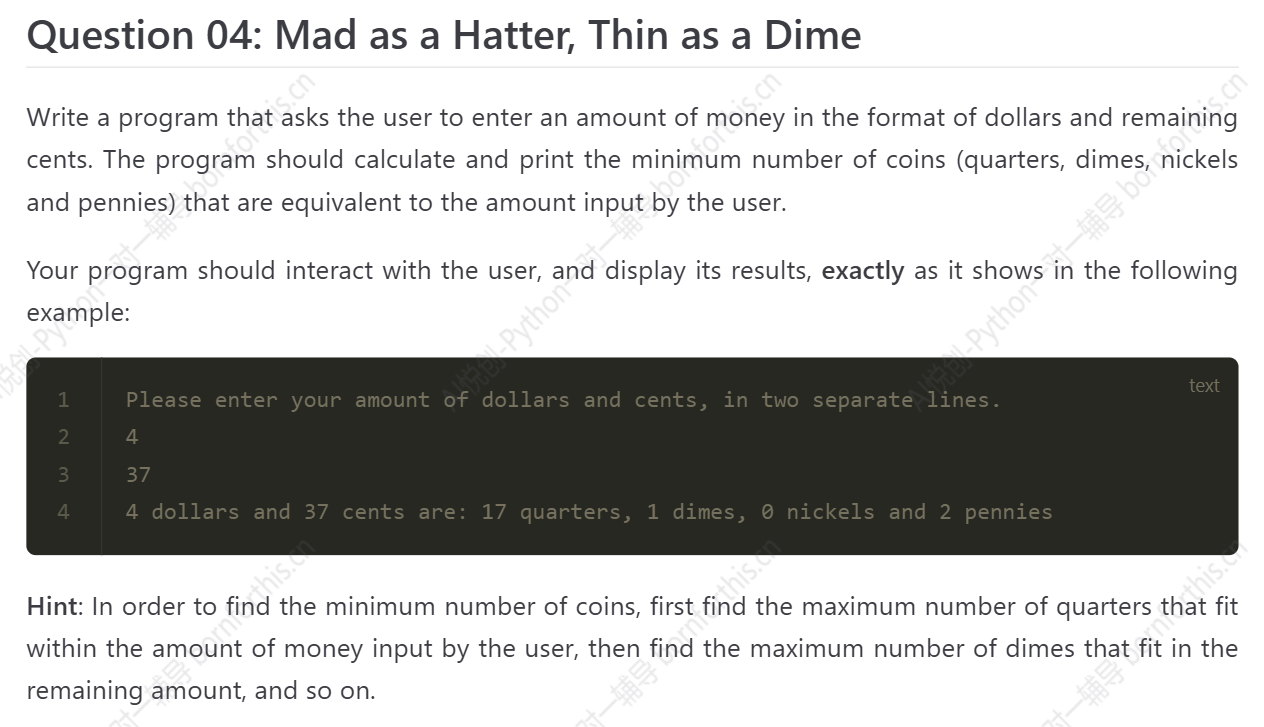
Answer 04:
print('Please enter your amount of dollars and cents, in two separate lines.')
dollars = int(input())
cents = int(input())
total_c = 100*dollars + cents
num_quarters = total_c// 25
num_dimes = (total_c % 25) // 10
num_nickels = ((total_c % 25) % 10) // 5
num_pennies = total_c - (25*num_quarters + 10*num_dimes + 5*num_nickels)
print(dollars, 'dollars and', cents, 'cents are:', num_quarters, 'quarters,', num_dimes, 'dimes,', num_nickels, 'nickels, and', num_pennies, 'pennies.')
#-------output-------
Please enter your amount of dollars and cents, in two separate lines.
4
37
4 dollars and 37 cents are: 17 quarters, 1 dimes, 0 nickels, and 2 pennies.修改优化:
#用户输入提示语
print('Please enter your amount of dollars and cents, in two separate lines.')
#获取用户输入,并转换为整数
dollars = int(input())
cents = int(input())
#计算输入总价值 (单位:美分)
total_c = 100*dollars + cents
#计算四种硬币总和最少数量
num_quarters = total_c// 25
remaining = total_c % 25
num_dimes = remaining // 10
remaining = remaining % 10
num_nickels = remaining // 5
num_pennies = remaining % 5
#输出结果
print(f'{dollars} dollars and {cents} cents are: {num_quarters} quarters, {num_dimes} dimes, {num_nickels} nickels and {num_pennies} pennies.')
#-------output-------
Please enter your amount of dollars and cents, in two separate lines.
4
37
4 dollars and 37 cents are: 17 quarters, 1 dimes, 0 nickels, and 2 pennies.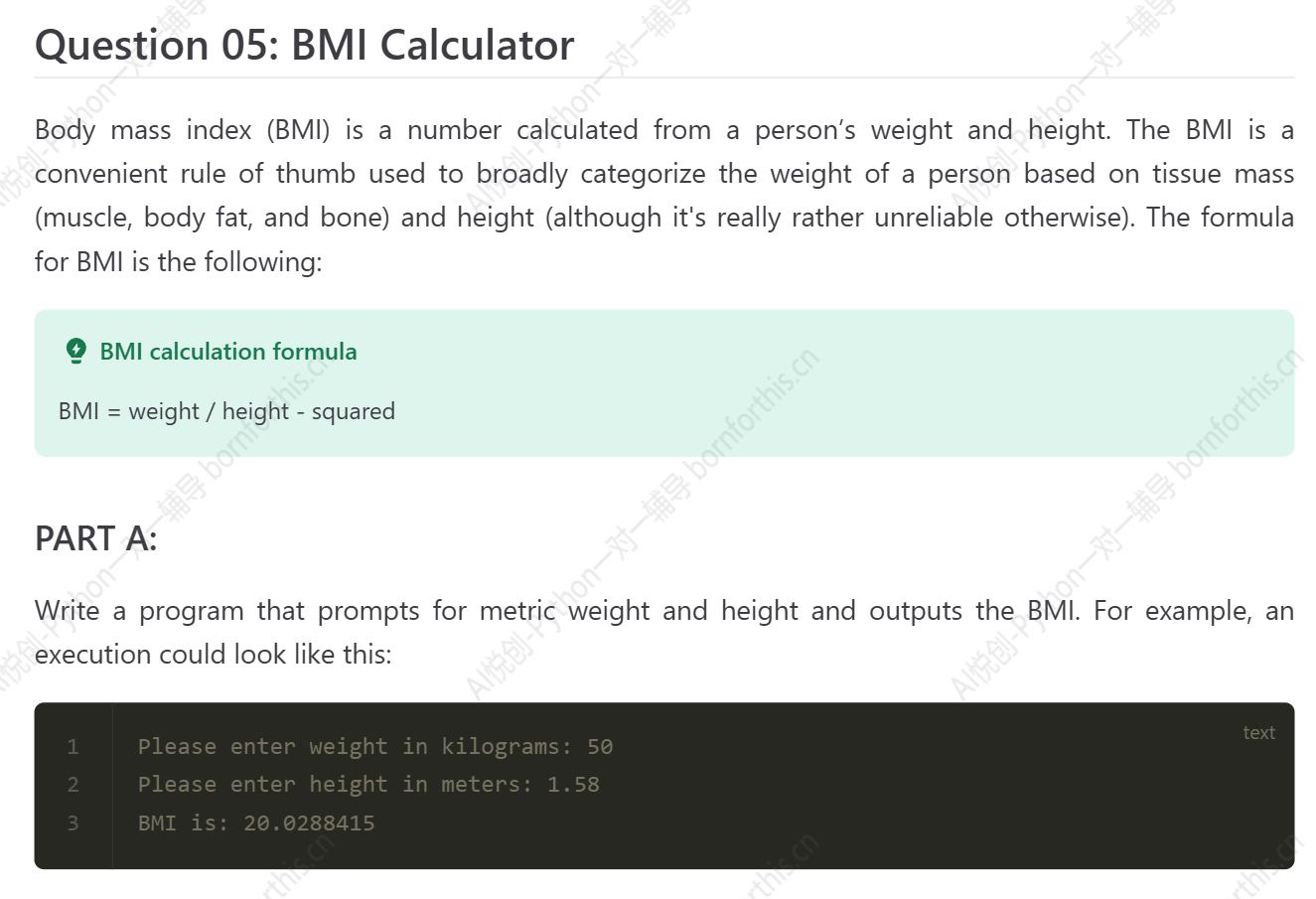
Answer 05 PART A:
weight = float(input('Please enter weight in kilograms:'))
height = float(input('Please enter height in meters:'))
BMI = weight / (height * height)
print('BMI is:', round(BMI, 7))
#-------output-------
Please enter weight in kilograms:50
Please enter height in meters:1.58
BMI is: 20.0288415其他保留小数点的方法:
#保留几位小数可以多种方法
print('BMI is: %.7f' % BMI)
print(f'BMI is: {BMI:.7f}')修改优化:
#请求用户输入体重 (千克)
weight_kg = float(input('Please enter weight in kilograms:'))
#请求用户输入身高 (米)
height_m= float(input('Please enter height in meters:'))
#调用函数计算BMI
BMI = weight_kg / (height_m ** 2)
print(f'BMI is: {BMI}')
#-------output-------
Please enter weight in kilograms:50
Please enter height in meters:1.58
BMI is: 20.028841531805796
Answer 05 PART B:
weight_pounds = float(input('Please enter weight in pounds:'))
height_inches = float(input('Please enter height in inches:'))
weight_kg = weight_pounds * 0.453592
height_m = height_inches * 0.0254
BMI = weight_kg / (height_m * height_m)
print('BMI is:', round(BMI, 8))
#-------output-------
Please enter weight in pounds:135
Please enter height in inches:71
BMI is: 18.82846971修改优化:
#请求用户输入体重
weight_pounds = float(input('Please enter weight in pounds:'))
#请求用户输入身高
height_inches = float(input('Please enter height in inches:'))
#将磅转换为千克
weight_kg = weight_pounds * 0.453592
#将英寸转换成米
height_m = height_inches * 0.0254
BMI = weight_kg / (height_m ** 2)
print(f'BMI is:{BMI}')
#-------output-------
Please enter weight in pounds:135
Please enter height in inches:71
BMI is: 18.828469714070952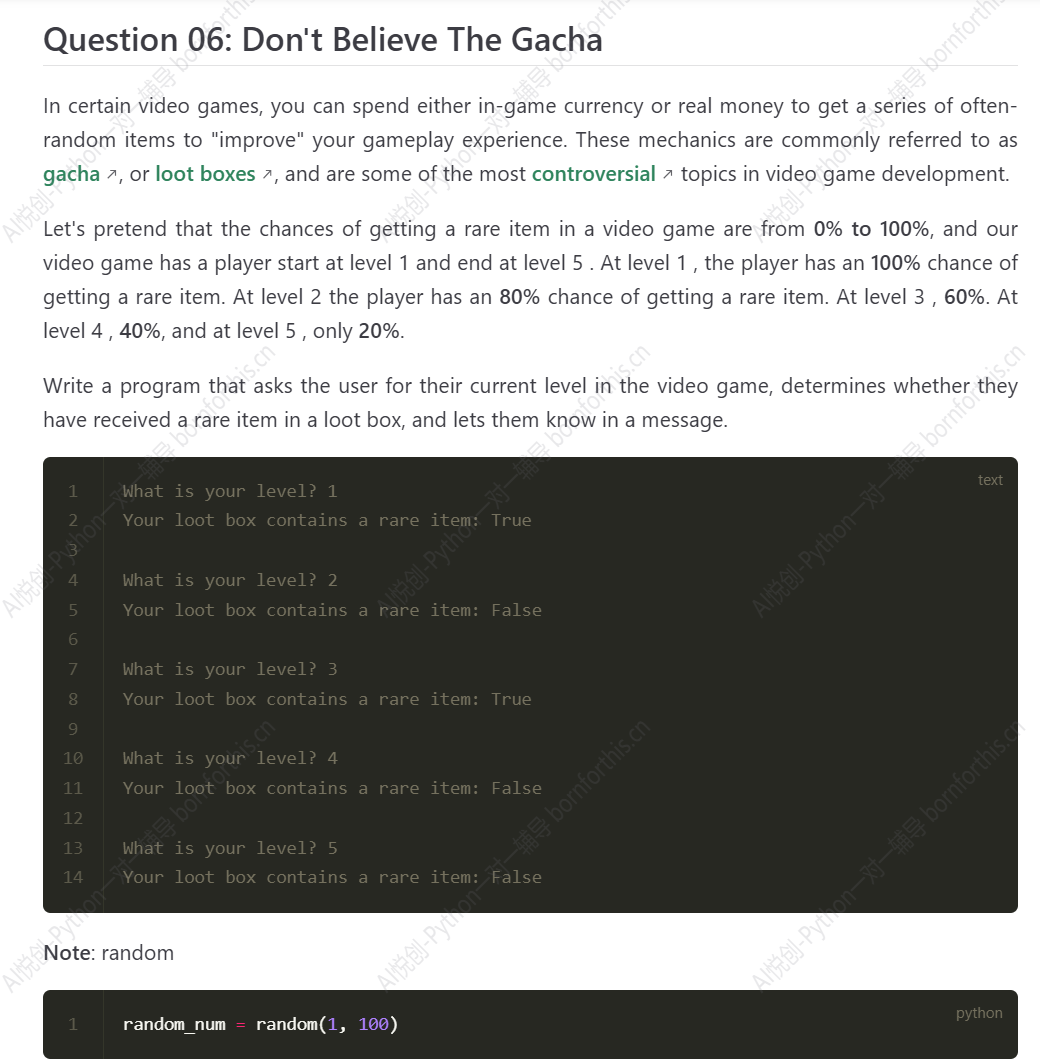
Answer 06:
import random
level = int(input('What is your level?\n'))
chance_max = 100-20*(level-1)
random_num = random.randint(0,100)
print('Your loot box contains a rare item:', random_num<=chance_max)
#-------output-------
What is your level?
5
Your loot box contains a rare item: True其他参考:
方法一:
import random
level = int(input("What is your current level? >>> "))
# 1 - 100% (5/5), 2 - 80% (4/5), 3 - 60% (3/5), 4 - 40% (2/5), 5 -20% (1/5)
target = random.randint(1, 6)
result = target % 5 > (level - 1)
print(f"Your hoot box contains a rare item: {result}")
方法二:
import random
random_num = random.randint(1, 100)
user_message =int(input("What is your level? "))
possibility = (5 - user_message + 1) * 20
camparison = random_num <= possibility
print(f"Your loot box contains a rare item: {camparison}")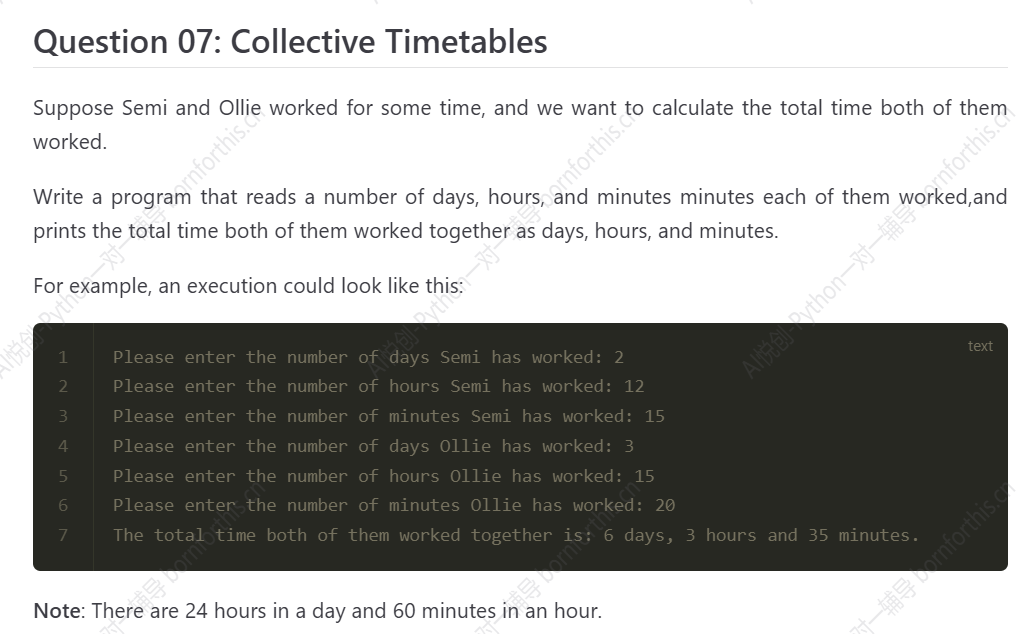
Semi_days = int(input('Please enter the number of days Semi has worked:'))
Semi_hours = int(input('Please enter the number of hours Semi has worked:'))
Semi_mins = int(input('Please enter the number of minutes Semi has worked:'))
Ollie_days = int(input('Please enter the number of days Ollie has worked:'))
Ollie_hours = int(input('Please enter the number of hours Ollie has worked:'))
Ollie_mins = int(input('Please enter the number of minutes Ollie has worked:'))
Semi_total_mins = Semi_days*24*60 + Semi_hours*60 + Semi_mins
Ollie_total_mins = Ollie_days*24*60 +Ollie_hours*60 + Ollie_mins
total_days = (Semi_total_mins + Ollie_total_mins)//(24*60)
total_hours = ((Semi_total_mins + Ollie_total_mins)%(24*60))//60
total_mins = (Semi_total_mins + Ollie_total_mins)-total_days*24*60-total_hours*60
print('The total time both of them worked together is:', total_days, 'days', total_hours, 'hours and', total_mins, 'minutes.')
#-------output-------
Please enter the number of days Semi has worked:2
Please enter the number of hours Semi has worked:12
Please enter the number of minutes Semi has worked:15
Please enter the number of days Ollie has worked:3
Please enter the number of hours Ollie has worked:15
Please enter the number of minutes Ollie has worked:20
The total time both of them worked together is: 6 days 3 hours and 35 minutes.修改优化:
#获取Semi输入,并转化为整数
Semi_days = int(input('Please enter the number of days Semi has worked:'))
Semi_hours = int(input('Please enter the number of hours Semi has worked:'))
Semi_mins = int(input('Please enter the number of minutes Semi has worked:'))
#获取Ollie输入,并转化为整数
Ollie_days = int(input('Please enter the number of days Ollie has worked:'))
Ollie_hours = int(input('Please enter the number of hours Ollie has worked:'))
Ollie_mins = int(input('Please enter the number of minutes Ollie has worked:'))
#将Semi的工作时间转换成分钟
Semi_total_mins = Semi_days*24*60 + Semi_hours*60 + Semi_mins
#将Ollie的工作时间转换成分钟
Ollie_total_mins = Ollie_days*24*60 +Ollie_hours*60 + Ollie_mins
#计算Semi和Ollie的工作总时间(单位:分钟)
total_minutes = Ollie_total_mins + Semi_total_mins
total_days = total_minutes // (24*60)
total_hours = total_minutes % (24*60) // 60
total_mins = total_minutes % (24*60) % 60
print(f'The total time both of them worked together is:{total_days} days, {total_hours} hours and {total_mins} minutes.')
#-------output-------
Please enter the number of days Semi has worked:2
Please enter the number of hours Semi has worked:12
Please enter the number of minutes Semi has worked:15
Please enter the number of days Ollie has worked:3
Please enter the number of hours Ollie has worked:15
Please enter the number of minutes Ollie has worked:20
The total time both of them worked together is:6 days, 3 hours and 35 minutes.更新日志
b0bfc-于cd421-于9d836-于f714e-于c753b-于6dcc6-于096f5-于b7e55-于52032-于edc3c-于5b593-于46a6b-于e2b2f-于b21c8-于9149c-于ec738-于
